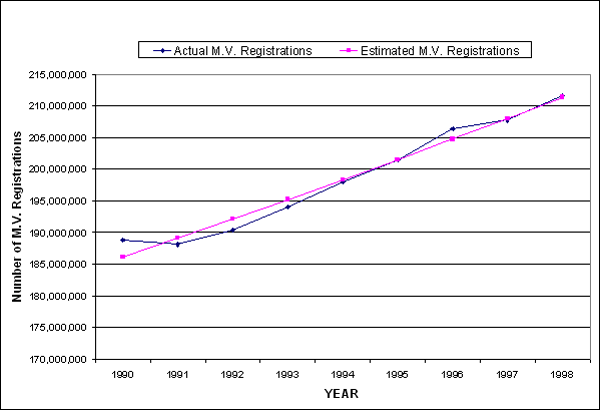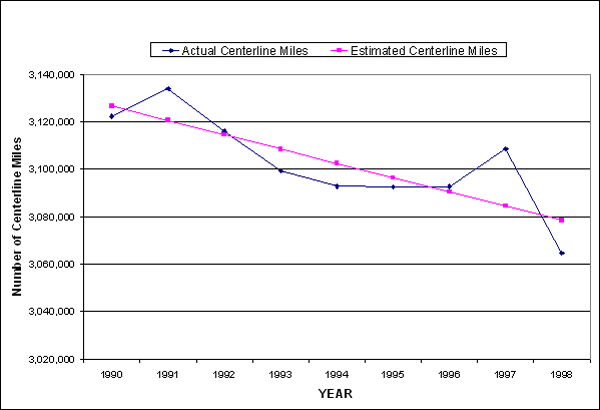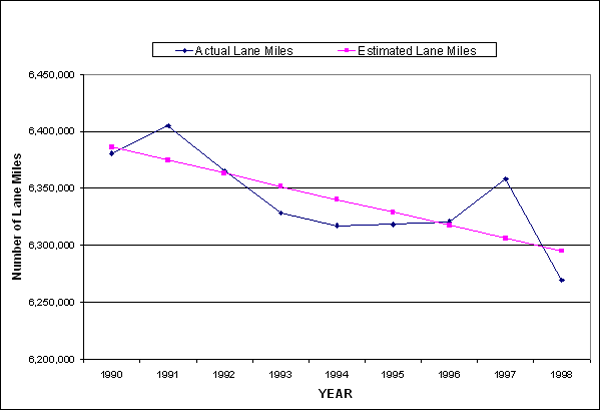How Much Does It Cost To Paint A Road
Publication Number: FHWA-HRT-04-142
Date: December 2005
Enhanced Night Visibility Series, Volume XI: Phase II—Cost-Benefit Analysis
PDF files can exist viewed with the Acrobat® Reader®
CHAPTER iii—COST Estimation
One facet of the cost-benefit analysis encompasses the price of the VESs and the fluorescent materials, also as the toll of any changes to required miscellaneous equipment (east.grand., headlamp ballast, paint trucks) that back-trail these technologies.
Examination RESULTS PERTAINING TO Cost
The pavement marking materials were monitored for changes over time in retroreflectivity, apparent colour, and (in the case of the fluorescent materials) fluorescent efficiency. Tabular array 2 lists the estimated service life of each experimental material and the historical average service life of the conventional materials used in Virginia.
| Name | Service Life (years) | |
|---|---|---|
| Pavement Markings | Fluorescent Latex | 0.5 |
| Fluorescent Thermoplastic | two.0 | |
| Nonfluorescent Pigment | 0.v | |
| Delineator Posts | Fluorescent | 1.0 |
| Nonfluorescent | 1.0 |
COST Information FROM OTHER SOURCES
Headlamps
The service lives evaluated in the price-benefit study are estimates supplied by the manufacturers. The contractor paid its supplier $i,300 each for the UV–A headlamps and ballasts that were installed on the experimental vehicles used for the Smart Road testing. The unit toll of the hybrid UV–A headlamps (provided by Visteon®) was not available. According to Consumer Guide ®, the infrared (IR) night vision system in the 2002 Cadillac® DeVille® DHS had an invoice cost of $1,913 and a suggested retail toll of $2,250.(9) A Cadillac dealer in Charlottesville, VA, quoted a retail price of $two,895 for the infrared night vision system in the 2003 DeVille DHS.(x)
Pavement Markings
In fall 1999, three dissimilar types of pavement markings were installed on the Smart Road. 2 of the three types of markings, a hydrocarbon-resin-based thermoplastic (Cleanosol®) and a latex-based pigment (Mercalin®), had fluorescent properties. The third, a polyurea binder organisation (3M® Liquid System 1200TM), served as a nonfluorescent control material. Pavement marking costs were from $0.0645 to $2.3476 per linear foot (lf) for the fluorescent paints and thermoplastics that were used in the field tests. A representative of the supplier provided an estimate of the price of the polyurea binder organisation. Table 3 through table 11 itemize the cost per linear pes (lf) of each pavement marker fabric that was used in the Smart Route tests, plus the average cost per linear human foot of the conventional thermoplastics and paints that the Virginia Department of Transportation (VDOT) uses in the field. Materials practical and tested on the Smart Road are marked with an asterisk. Price figures used in the cost-benefit analysis are marked with two asterisks. Other materials and cost figures are unmarked. Delineator post unit costs are expressed in dollars per post. All other unit of measurement costs are expressed in dollars per linear foot; 1 lf = 0.305 linear meter (lm).
| White Fluorescent Thermoplastic* | Yellow Fluorescent Thermoplastic | |||
|---|---|---|---|---|
| Add. Toll Info | Project | Discounted | Project | Discounted |
| Fabric Toll | 0.724 | 0.5570 | 0.8890 | 0.6838 |
| Labor Cost | 0.200 | 0.2000 | 0.2000 | 0.2000 |
| Toll w/o Chaplet | 0.924 | 0.7570 | one.0890 | 0.8838 |
| Cost west/Conv. Chaplet | 0.949 | 0.7819 | 1.1139 | 0.9087 |
| Cost west/Fluor. Chaplet | **ane.9222 | ane.7552 | ii.5527 | 2.3475 |
| White Fluorescent Pigment* | Yellow Fluorescent Paint | |||
|---|---|---|---|---|
| Add. Toll Info | Project | Discounted | Projection | Discounted |
| Fabric Price | 0.1720 | 0.1203 | 0.1461 | 0.1023 |
| Labor Cost | 0.0635 | 0.0635 | 0.0635 | 0.0635 |
| Cost w/o Beads | 0.2355 | 0.1838 | 0.2096 | 0.1658 |
| Cost w/Conv. Beads | 0.2392 | 0.1875 | 0.2133 | 0.1695 |
| Toll w/Fluor. Beads | **0.3847 | 0.3330 | 0.4284 | 0.3846 |
| White Fluorescent Glass Beads | Yellow Fluorescent Glass Chaplet | |||
|---|---|---|---|---|
| In Pigment | In Thermo. | In Paint | In Thermo. | |
| Material Price | 0.1492 | 0.9982 | 0.2188 | 1.4637 |
| Labor Price | ||||
| Toll w/o Chaplet | ||||
| Cost w/Conv. Beads | ||||
| Cost w/Fluor. Beads | ||||
| Fluorescent Delineator | ||
|---|---|---|
| Without Sheeting | With Sheeting | |
| Material Cost | 10.68 | 12.18 |
| Labor Cost | ||
| Toll westward/o Beads | ||
| Price w/Conv. Beads | ||
| Cost w/Fluor. Beads | ||
| White Polyurea Binder* | ||
|---|---|---|
| Y2000 | Y2003 | |
| Cloth Cost | ||
| Labor Cost | ||
| Cost w/o Beads | 0.75 | **1.0000 |
| Cost due west/Conv. Beads | ||
| Cost w/Fluor. Chaplet | ||
| White Conventional Thermoplastic | Yellow Conventional Thermoplastic | |||
|---|---|---|---|---|
| Depression-cease | Loftier-stop | Low-end | High-terminate | |
| Textile Cost | 0.0960 | 0.1260 | 0.0960 | 0.1260 |
| Labor Toll | 0.2000 | 0.2000 | 0.2000 | 0.2000 |
| Cost w/o Beads | 0.2960 | 0.3260 | 0.2960 | 0.3260 |
| Cost w/Conv. Beads | 0.3209 | 0.3509 | 0.3209 | 0.3509 |
| Cost westward/Fluor. Beads | Northward/A | N/A | N/A | Northward/A |
| White Conventional Paint | Yellow Conventional Paint | |||
|---|---|---|---|---|
| Depression-end | High-terminate | Low-stop | Loftier-end | |
| Material Cost | 0.0097 | 0.0104 | 0.0122 | 0.0133 |
| Labor Cost | 0.0635 | 0.0635 | 0.0635 | 0.0635 |
| Cost w/o Beads | 0.0732 | 0.0739 | 0.0757 | 0.0768 |
| Cost w/Conv. Beads | 0.0769 | 0.0776 | 0.0794 | 0.0805 |
| Cost w/Fluor. Beads | N/A | N/A | N/A | N/A |
| Conventional Glass Beads | ||
|---|---|---|
| In Paint | In Thermo. | |
| Fabric Cost | 0.0037 | 0.0249 |
| Labor Price | ||
| Cost west/o Beads | ||
| Price due west/Conv. Chaplet | ||
| Cost westward/Fluor. Beads | ||
| Standard Delineator | ||
|---|---|---|
| Without Sheeting | With Sheeting | |
| Textile Cost | 13.24 | xiv.74 |
| Labor Price | ||
| Price due west/o Chaplet | ||
| Toll west/Conv. Beads | ||
| Cost w/Fluor. Beads | ||
It was found that the labor and equipment toll per linear foot of installing a fluorescent marking cloth is identical to the price of installing its nonfluorescent analogue.
In addition to pavement markings—fluorescent and conventional nonfluorescent—delineator posts were installed forth the side of the roadway. Their costs are tabulated in table half-dozen and table 11.(11) Considering the delineator posts played no part in the visibility tests, their costs are excluded from the cost-benefit analysis.
COST METHODOLOGY
The Federal Highway Administration's (FHWA) almanac Highway Statistics supplies historical tallies of motor vehicle registrations, centerline miles of road, and lane miles of road.(12,13) This information was retrieved from 1990–1998. These data assist permit a forecast of the total toll of implementing any of the VESs or pavement markings.
Cost Principles—Automobile Equipment
The incremental cost of the UV–A technology takes into account the cost of the UV–A headlamps themselves, the price of their installation, and the cost of modifications to the vehicle's torso and electrical system to fit the headlamps and ability them. The differential cost of producing new vehicles that are designed to operate UV–A headlamps would possibly be less than the cost of retrofitting existing vehicle models.
It is quite possible that the unit cost of UV–A headlamps in mass production volition differ from the concessionary prices paid for the experimental equipment; however, spokespersons for the motorcar industry were hesitant to forecast the unit of measurement toll of the headlamps in mass production. The cost analysis computes the incremental price of each headlamp engineering on the supposition that the steady-state cost of equipping a new automobile with such headlamps would be equal to the prices the contractor has on record.
The average replacement age of the headlamps is causeless to be viii years, matching the assumption made in the previous FHWA evaluation of UV–A headlamps.(i) The average replacement age of the thermal imaging system is assumed to be the same.
Price Principles—Pavement Markings
A computation of the incremental toll of a fluorescent technology takes in the up-forepart price of the fluorescent materials themselves, the differential toll of their installation, and the deviation in the length of the replacement cycle (i.east., the service life). Each of the fluorescent materials tested was a fluorescent variant of a marking material already in apply, namely thermoplastic or paint. The nonfluorescent control was a polyurea binder system. The standard nonfluorescent pigment that VDOT uses is less expensive than any of the three alternatives that underwent sight-altitude tests on the Smart Route. Because the engineering for applying a given type of pavement marking is largely independent of the cloth's fluorescent properties, the cost-benefit analysis assumes no differential installation cost (i.e., that the installation cost of fluorescent paint is no dissimilar from the installation toll of conventional paint, and that the installation cost of fluorescent thermoplastic is no different from the installation cost of conventional thermoplastic).
As in the case of the headlamps, authoritative estimates of the unit toll of each fluorescent material in mass production were non available. The cost-do good analysis computes the annualized costs of each pavement marking technology on the assumption that the steady-state cost of procuring fluorescent pavement markings would equal the prices that were actually paid. The average replacement age of the thermoplastic, either fluorescent or nonfluorescent, is taken to be 3 years. The average replacement historic period of the paint, either fluorescent or nonfluorescent, is taken to exist one year. Both of these assumptions reflect VDOT experience with the conventional nonfluorescent products.
Cost Computations—Automobile Equipment
A simple log linear equation as shown in figure 3—where y is the forecast quantity, x is the yr, and m and b are constants—was fitted to 9 years of annual FHWA statistics on the number of motor vehicle registrations in the United States 1990 through 1998.(12,13) The equation is used to create a 20-twelvemonth forward forecast of motor vehicle registrations. Figure 4 compares the actual number of motor vehicle registrations in each yr with the number implied past the fitted equation:
![]()
Figure 3. Equation. Cost ciphering.

Figure 4. Line graph. Motor vehicle registrations 1990 through 1998.(12,13)
The forecast of registered motor vehicles measures the size of the market that a new VES would have to penetrate. The reported results are given on the assumption that this penetration would occur over a 20-twelvemonth catamenia in equal five percent increments from the start year until 100 percent implementation was accomplished. The annualized cost of a given VES is applied to the number of equipped vehicles forecast in each futurity twelvemonth to yield a full price judge for that yr.
Cost Computations—Pavement Markings
The number of stripes needed to mark a given segment of highway is causeless to equal the number of lanes plus one. Nether this assumption, the sum of the number of highway centerline miles plus the number of highway lane miles equals the number of miles of striping that would demand to exist placed on the Nation's roads.
The simple log linear equation in effigy 3 was fitted to ix years of almanac FHWA statistics on the number of highway (centerline) miles of road in the United States from 1990 through 1998.(12,xiii) The aforementioned equation was fitted to 9 years of data on the number of lane-miles of road.(12,13)
Effigy 5 compares the actual number of centerline miles in each year with the number implied by the fitted equation. Figure six does the same for lane miles on rural roads. Each equation is used to create a twenty-year forward forecast of the time serial to which information technology was fitted. The forecast of each quantity is contained of the forecasts of the other.

Figure 5. Line graph. Centerline miles for highways from 1990 through 1998.(12,13)

Figure 6. Line graph. Lane miles of rural highway 1990 through 1998.(12,13)
It is assumed that implementation would occur simply on unlighted highway segments. Considering a tally of the number of unlighted highway miles was non readily available, the number of miles of rural highway is used as a proxy. Information technology is causeless further that installation of a new marking system would occur over 20 years, in equal 5 per centum increments from the starting time yr until 100 percent implementation is achieved. The annualized cost of a given marking material is applied to the number of retrofitted miles of stripe forecast for a futurity year to yield a full cost for that year.
Additional Considerations
A case could be made that the graph of marketplace penetration over time should be S-shaped, reflecting hesitant initial adoption, followed past a smash of installation that tails off as the number of unequipped vehicles and highway miles asymptotically approaches 0 percentage. Given the results from the Smart Route field tests, it is not conceivable that such a modification would alter the price-benefit findings.
A case could also be made that a toll computation based on installation cost rather than annualized cost would reflect ameliorate the time path of the costs, especially during the early years of implementation. Once again, the cost-do good findings are not sensitive to such a modification. The reported results are based on a present-value calculation using annualized costs.
Source: https://www.fhwa.dot.gov/publications/research/safety/humanfac/04142/costest.cfm
Posted by: keyyouts1951.blogspot.com


0 Response to "How Much Does It Cost To Paint A Road"
Post a Comment